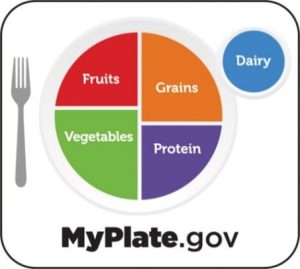As a dietitian, one of the main complaints I hear from patients is how expensive eating healthy can be or how little time they have to prepare nutritious meals. For others, eating well can feel daunting or overwhelming. Moreover, maintaining a healthy diet might seem impossible with food prices increasing due to inflation. This can be particularly concerning for families with school-aged children. Extracurricular fees and school supplies add to family expenses for kids going back to school and for homeschooling families. However, there are many strategies you can use to feed your family nutritious meals on a budget. Let’s explore practical ideas to help you save money while providing healthy meals and snacks.
- Use MyPlate as a meal planning tool. When planning meals, use the MyPlate model to ensure you prepare balanced meals at home, and meals on the go, like sack lunches for school. For snacks, aim to include at least two food groups (e.g., fruit and nuts or veggies and protein). For meals, include all five food groups (or work up to all five, if you’re feeling overwhelmed). Here’s an example meal:
-
- A carbohydrate (e.g., whole wheat pasta, brown rice or starchy vegetables)
- A non-starchy vegetable (e.g., broccoli, carrots, green beans)
- A lean protein (e.g., chicken, ground turkey, pork chops, tilapia)
- A fruit serving (e.g., small apple, small serving of berries)
- A serving of dairy (e.g., 8oz milk)
- Plan ahead with a weekly menu. The first step to eating healthy on a budget is planning. Creating a weekly menu that includes healthy family favorites helps you identify what ingredients you need to buy and what you already have in your pantry. Planning ahead also allows you to thaw frozen items ahead of time and reduce food waste.
- Make a grocery list and stick to it. Use your menu to create a shopping list. Take this list to your favorite grocery store and stick to it. Avoid adding items that aren’t on the list. Don’t shop while hungry! It can lead to impulse purchases that are not part of your meal plan.
- Use seasonal produce and store brands. Buy fruits and vegetables that are in season, as they’re often cheaper and fresher. Pick produce your children love and that survive well in lunch boxes. Sturdy ones like apples, grapes, broccoli, carrots or celery and dip are good choices. Opt for store-brand products, which usually offer good quality at a lower price. Also, use coupons from stores or manufacturers to save even more. Don’t forget the commissary is a valuable benefit for military members, offering competitive prices that can help you stretch your grocery budget further.
- Shop in bulk. If you have a membership to a warehouse club, consider buying staple items like dairy, cereals and bread in bulk. Just be mindful of expiration dates to avoid wasting food. Avoid pre-portioned or convenience foods when possible, as they cost more. Instead, buy in bulk and portion items yourself at home.
- Mix fresh, frozen and canned produce. You don’t always have to buy fresh produce. A combination of fresh, frozen and canned fruits and vegetables can be both nutritious and budget-friendly. Eat the fresh items first, then use frozen and canned as the week goes on.
- Meal prep on weekends. For busy families, meal prepping on weekends can be a game changer. With meals prepared ahead of time, you’re less likely to rely on fast food after work or school.
- Involve your kids. Involve children in meal planning, grocery shopping and meal prep. This can make them more interested in healthy foods and give you a chance to teach them about nutrition. Give them choices; for example, let them pick which fruits, vegetables or cereals they prefer. This promotes independence and makes them more likely to eat what they’ve helped choose or prepare.
Eating healthy doesn’t have to be expensive or overwhelming. With a bit of planning, smart shopping and family involvement, you can make nutritious meals a regular part of your routine while staying on budget. Start small, be consistent, and remember that every step you take toward healthier eating is a step toward better overall well-being for you and your family.

CPT Frances White, DCN, RD, CSR, CNSC, is a registered dietitian with the U.S. Army Medical Department. She is a bilingual nutrition professional with expertise in both management and clinical nutrition. CPT White is passionate about empowering patients to understand how dietary changes can significantly improve their health and overall well-being.
Blog Brigade unites military spouses by creating a community built on shared experiences and mutual support. Navigating the complexities of military life can be challenging, but you don’t have to do it alone. Military OneSource offers valuable resources focused on well-being, readiness, and connection. Explore a range of nutrition resources and tools tailored to your needs.




